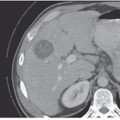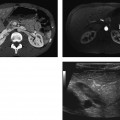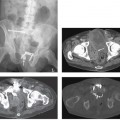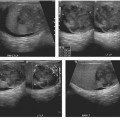II Gallbladder and Bile Ducts
CASE 12
Clinical Presentation
A 45-year-old woman complains of unremitting right upper quadrant pain.

Fig. 12.1 Axial contrast-enhanced CT image showing a distended gallbladder with wall thickening and pericholecystic fat stranding. No gallstones are seen in this case of acalculous cholecystitis.
Radiologic Findings
Axial computed tomography (CT) image shows a distended gallbladder with wall thickening and pericholecystic inflammatory fat stranding (Fig. 12.1).
Diagnosis
Acute acalculous cholecystitis
Differential Diagnosis
- Peptic ulcer disease
- Colonic diverticulitis
- Acute pancreatitis
- Liver abscess
Discussion
Background
Cholecystitis is a common complication of gallstones. Although gallstones are more frequently encountered in women, male patients with gallstones are more likely to have cholecystitis than female patients.
Clinical Findings
Most common symptoms are right upper quadrant pain radiating to the back or right scapula (usually brought about by having fatty food), associated with fever, nausea, and vomiting. Patients typically have a history of similar episodes in the past with symptoms resolving after some time.
Complications
- Gangrenous cholecystitis
- Gallbladder perforation
- Empyema
- Cholangitis
- Pancreatitis
- Gallstone ileus
- Liver abscess
- Emphysematous cholecystitis
- Septicemia
- Cholecystoenteric fistula (Bouveret syndrome; gallstone eroding into the duodenum, causing an obstruction)
- Chronic calculus cholecystitis
Etiology
Cholecystitis is usually the result of an acute obstruction of the gallbladder by calculi (calculus cholecystitis). Acalculus cholecystitis can be seen in enteric fever, diabetes, acquired immunodeficiency syndrome (AIDS), certain vascular diseases, burns, and sepsis; hospitalized fasting patients on total parenteral nutrition and critically ill patients are at risk. Emphysematous cholecystitis is an infection caused by gas-forming organisms and can be seen in older men, people with type 2 diabetes, and immunocompromised patients.
Imaging Findings
Stay updated, free articles. Join our Telegram channel

Full access? Get Clinical Tree








